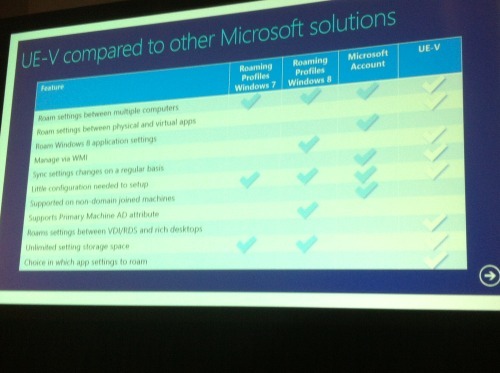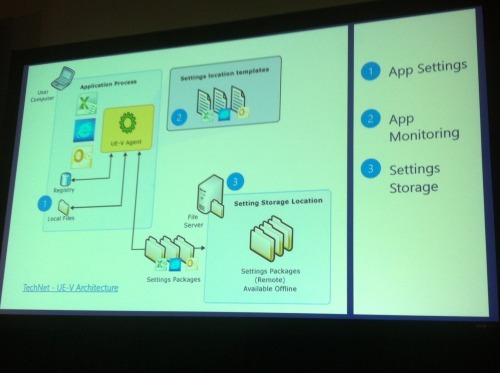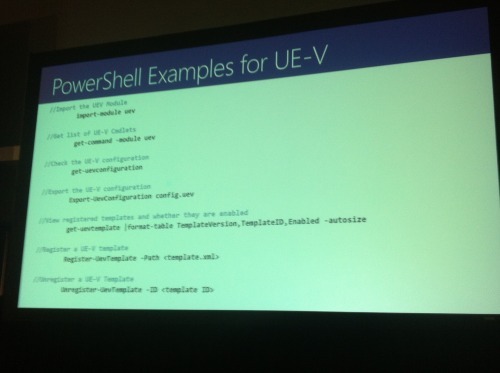Speaker: Tim Crabb
UE-V is an enterprise-scale user state virtualization solution that that keeps users’ experience with them. It allows them choice to change their device and keep their experience so that they don’t have to reconfigure applications each time they login to Windows 7 or Windows 8. Regardless if it is a rich desktop or a VDI session, UE-V enables a consistent, personal Windows experience that matches their unique work style. From this class I hope to learn more about using UEV to enable user state virtualization. UEV claims to be able to be up and running in minutes, and is straight forward to use and manage.
"Change the device, keep the experience". The idea is we need to keep the experience clean and trustworthy in BYOD, or break-fix situations.
With UEV the syncs are smart and fast, there's not application or OS reconfiguration needed. The templates available will automate identification of settings location; we can control which apps navigate, and we can roll it back. ConfigMgr2012 DCM packs keep client config consistent. "It seamlessly integrates into MDOP"
When should I use it? When you want granular control. UEV gives faster login by selectively picking what roams and upon what triggers. We also want UEV when we're in a mixed desktop environment such as a kiosk, shared machines, VDI, traditional desktop. There's a great integration with APP-V. While not required, it is a pretty neat experience.

How it works- We manage app settings and define templates, then using app monitoring we can determine what the triggers are for pulling settings in. The storage for UEV is of course configurable. It could be per user, per OU, per domain, really any way you want. Something to be aware of is that last write wins, there's not snapshotting or anything; so just like a standard profile guys- now this isn't all that scary if you think about it. How often do you change settings in Word, Outlook, etc? Not often. We change stuff, but it's usually a file not a setting.

Here's some great resources for you guys on UE-V http://technet.microsoft.com/en-us/windows/hh943107.aspx UE-V integrates with Windows Folder Redirection that centralizes user folders such as documents, pictures, desktop, application data, and other folders where user or application data can stored to a server in the Datacenter, that makes these folders accessible to this user from any other pc that they log in from.
They keep liking to show me simple apps like calculator, desktop, etc. No surprise- Office works. I'll grant you that many users stick to the standard stuff, but what about the tough stuff like LOB apps? Well, it's a short class so I might not get to find out, but watch for future blogs on UE-V; I'll plan to set this up and see what I can get happening and what I can't. I'd also like to see how much of this I can do on my own with a K1000.
That's a good segway into how to deploy.
1- Configure a settings storage location
2- Configure the UEV Agent
3- Select/Create settings location templates
4- Deploy/Manage settings location templates
Configure a settings storage location: UEV doesn't require a server, just a SMB share. ~5MB per user typically per app. So if you have 5 apps- 25MB per user is a good threshold. Make sure you give the users rights (full control). The UEV agent will create and secure the user folders, as the user.
Configure the UEV Agent: The agent is an MSI or EXE and it's standard quiet stuff. The exe does have a GUI. We do need .Net 3.5 and/or 4.0 in some cases. Don't forget to tell UEV where the store is when you deploy ! It does require a reboot for OS settings roaming. You can actually

Looking at option 3 above- that might be useful where we don't need to capture stuff like in VDI; but if we did that on a laptop it might not make the user very happy. Option 4 above allows us to be in a dormant state such as during an image prep.
Select/Create settings location templates: Templates describe what and where files and registry info are. They are XML based and will include app name, UID, process and version info, and locations. There's also a community sharing templates. Desktops settings are synchronous, so by default they are turned off because synchronous means log-in time. The UEV Generator allows you to create your own custom templates. We're taking a look at an Adobe Acrobat template, it's a simple XML with not a lot here, but how cool would it be if we set things up not to bug users for updates, or if we wanted to- we could inject the XML to turn it off globally.
Note that you can manually edit the XML but validate your work against the XSD or with the Generator. There's some things that aren't documented fully (yet) such as registry and file exclusions, architecture separation, shell process designation. Can I customize OS templates? Strongly recommended against, but they are pretty custom templates. Can I use variables? Yes. Custom or standard variables can be set. Here's a look at the Generator


Deploy/Manage settings location templates:
Catalogs are a central way to store and distribute templates, or it can be overridden. Templates are placed in a common location, and everything can be scheduled via GPO. The scheduled task is ApplySettingsTemplateCatalog.exe. 3 ways to manage: GPO, Config Packs, and PowerShell. The ADMX file for GPO is available and might roll well with a dormant deployment. Powershell and WMI commands allow for configuration, synchronization, etc.


Powershell commands
P:> import-module uev
P:> Get-UevConfiguration
P:> Get-uevTemplate | format-table templateversion,templateID,enabled -autozize

Lots of power, flexibility, and usability here. It's a relatively young and under baked product, but it could be one of the coolest things I've seen for the real user and environment out of Microsoft in years. This is right up there with the blue arrow for me.


Comments